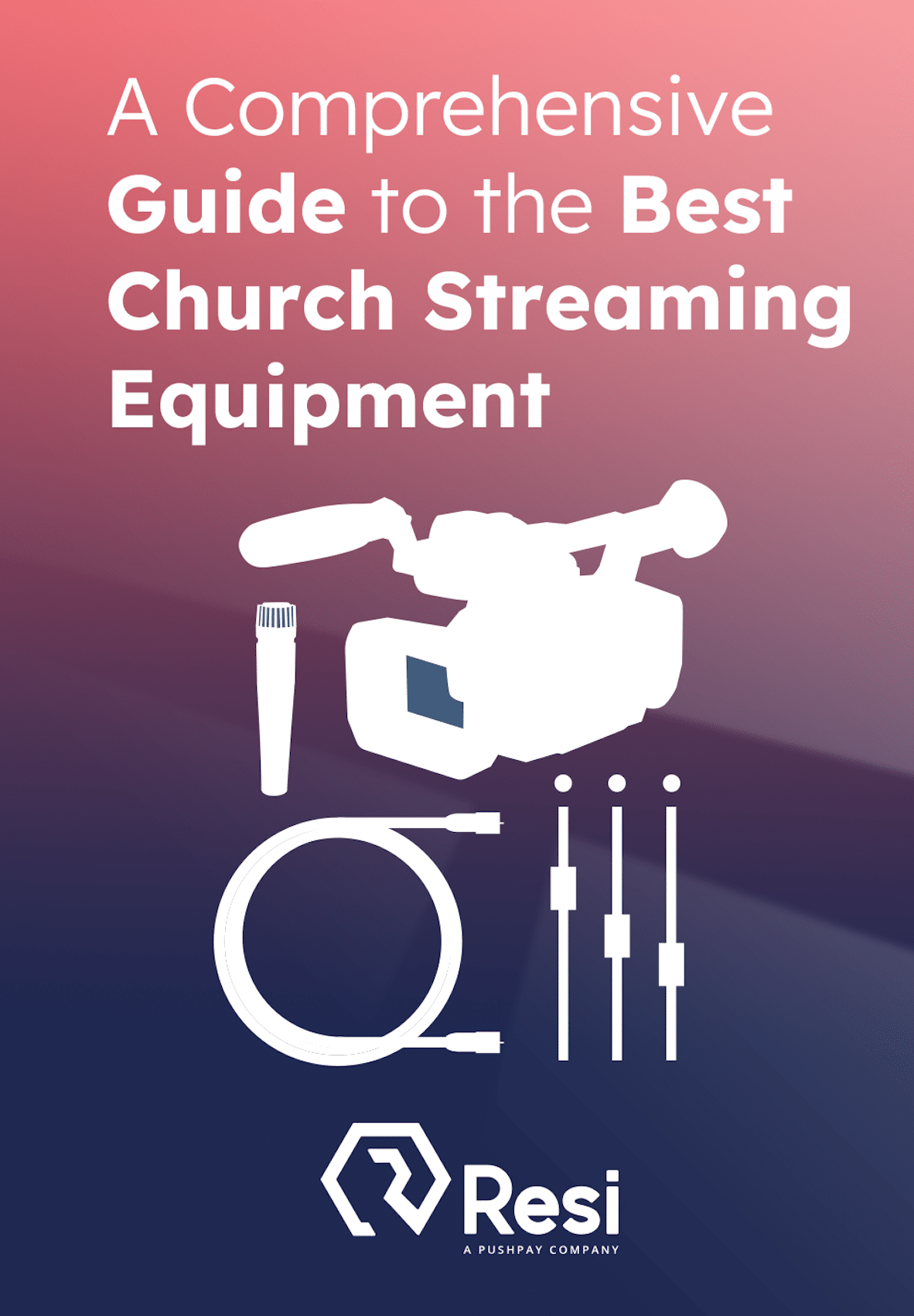
When you’re broadcasting Sunday services, having the right sound system setup is necessary for delivering clear, high-quality audio that brings your church service into the homes of your congregation.
A well-designed church sound system has to do two things:
- make sure the spoken word comes across clearly (puts a priority around speech intelligibility)
- make sure the music in your worship services sounds just as it would in person.
However, choosing the right equipment and configuration can be daunting, given the myriad of options available. From microphones and mixers to audio interfaces and speakers, each component plays a vital role in achieving professional-grade sound.
In this guide, we’ll explore the key elements of an effective church sound system for livestreaming.
Understanding the Basics of Church Sound Systems for Livestreaming
It’s important to grasp the fundamentals of sound systems designed for church livestreaming. At its core, a sound system for church livestreaming aims to capture, process, and transmit audio with minimal loss of quality. This involves a combination of hardware and software working together to ensure that the sound reaching your online audience is as clear and engaging as it is in your physical sanctuary.
Key Components of a Sound System
Creating a top-notch sound system for your livestreams involves piecing together several essential components. Each part plays a vital role in delivering clear, high-quality audio that keeps your audience engaged. Let’s break down the audio equipment and other key elements of a sound system built for church worship:
Microphones
Microphones are where it all begins—they’re the first point of contact for capturing sound. In a church setting, having the right microphone can make a significant difference in the quality of your audio. Here’s a breakdown of the types you might use:
- Lavalier Microphones: These are great for pastors or speakers who need the freedom to move around. They clip onto clothing, providing hands-free operation and consistent sound quality.
- Handheld Microphones: These are the go-to choice for vocalists and soloists. They’re versatile, easy to use, and offer excellent control over sound.
- Condenser Microphones: Perfect for capturing choirs and musical instruments. Their high sensitivity and wide frequency response make them ideal for picking up the nuances of voices and instruments.
Selecting the right microphone involves considering the specific needs of your service and the unique acoustic environment of your church. For example, a large sanctuary with high ceilings might benefit from condenser mics to capture the rich sound of a worshiping congregation, while a smaller, more intimate space could do well with lavalier mics for clear and consistent speech.
Best Livestreaming Equipment
Discover what top-rated equipment we recommend adding to your church streaming toolkit.
Download for free!
Mixers
The mixer is the heart of your sound system, where all audio inputs converge. It’s the control center that lets you balance and fine-tune sound levels before sending the final mix to your livestream. Here are key features to look for in a mixer:
- Multiple Input Channels: Essential for handling all your microphones and instruments, multiple input channels mean that each audio source can be individually managed.
- EQ and Effects Processing: These tools are crucial for enhancing audio quality. EQ allows you to adjust frequencies to ensure clarity, while effects processing can add depth and polish to your sound.
- Digital Outputs: These make it easy to integrate your mixer with your livestream setup, ensuring a seamless connection to your broadcasting equipment.
Speakers
While speakers are primarily for those physically present, they play a critical role in ensuring your live sound is clear and balanced. Good speakers help monitor and adjust live sound, indirectly enhancing the quality of your livestream audio. They allow you to hear exactly what your audience hears, making it easier to fine-tune the mix and deliver the best possible sound online.
Amplifiers
Amplifiers are vital for boosting the audio signal to drive your speakers effectively. While some mixers have built-in amplifiers, larger setups often require external amplifiers for more power and flexibility. This added power ensures that your sound remains clear, regardless of the size of your auditorium or the demands of your audio setup.
Cables
High-quality cables reduce the risk of signal loss and interference. Common types include:
- XLR Cables: For microphones and mixers.
- ¼-inch Cables: For instruments and some speakers.
- Ethernet Cables: For digital audio networks and advanced mixers.
Optimizing Sound for Online Audiences
Creating a great sound experience for your online viewers is just as much about having the right equipment as it is about careful attention to balancing and managing audio to ensure clarity and consistency. Here’s how to optimize sound for your online audience:
Balancing Audio for Livestream
Balancing audio levels is so important for your church livestream. Here are some key points:
- Volume Consistency: Maintain consistent volume levels across different parts of the service to avoid jarring changes. This is especially important in the transition from worship to sermon!
- Equalization (EQ): Use EQ settings to balance frequencies. Enhance mid-range for speech clarity and adjust bass and treble for music.
- Compression: Manage dynamic range to keep quieter moments audible without loud sections becoming overwhelming.
- Monitoring: Regularly monitor audio output through headphones or studio monitors designed for accurate sound reproduction.
Dealing with Acoustic Challenges
Churches often have unique acoustics that can affect sound quality. Here are tips to manage acoustics:
- Acoustic Treatment: Use panels, curtains, or carpets to absorb sound and reduce echo.
- Microphone Placement: Position microphones to minimize unwanted noise.
- Directional Microphones: Use mics that focus on the sound source and reject off-axis noise.
- Soundproofing: If possible, soundproof areas to reduce external noise.
- Feedback Control: Use feedback suppression tools and proper speaker placement to manage feedback issues.
Advanced Sound System Features for Livestreaming
To take your audio quality to the next level, consider integrating these advanced features into your sound system:
- Digital Signal Processing (DSP): DSP allows for real-time modifications to enhance sound quality. This technology can clean up noise, adjust EQ settings dynamically, and apply effects that make your audio sound more polished and professional.
- Feedback Elimination: Utilize tools designed to detect and eliminate feedback. Feedback can be distracting and disruptive, but with the right equipment, you can manage and minimize it effectively.
- Latency Management: Syncing audio and video is crucial for a seamless livestream. Proper latency management ensures that your sound matches the visual feed perfectly, avoiding any disorienting delays.
Best Practices for Live Sound Checks
Conducting thorough sound checks before going live is essential to ensure optimal audio quality. Here’s a step-by-step guide:
- Start Early: Begin your sound checks well before the service starts. This gives you plenty of time to identify and resolve any issues.
- Test Each Component: Individually check microphones, instruments, and audio inputs. This helps pinpoint any problems and ensures everything is functioning correctly.
- Balance Levels: Adjust the volume levels of each audio source for a balanced mix. This ensures that no single element overpowers the others and that everything blends harmoniously.
- Monitor with Headphones: Use high-quality headphones to monitor sound directly from the mixer. This allows you to catch any issues that might not be audible through speakers.
- Test the Livestream Feed: Run a test stream to check the audio from the viewer’s perspective. This final step ensures that what your audience hears is clear, balanced, and professional.
Loud and Clear
As your church embraces live streaming, investing in a well-designed sound system and following best practices can elevate your worship services. High-quality audio means that your giving your message and music the best shot at resonating with your congregation, whether they are in the pews or watching from home.







